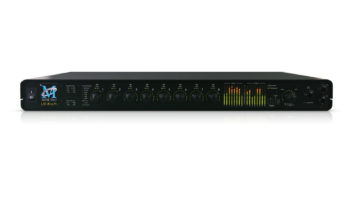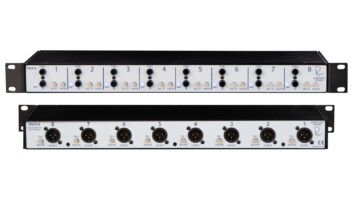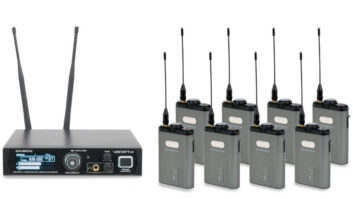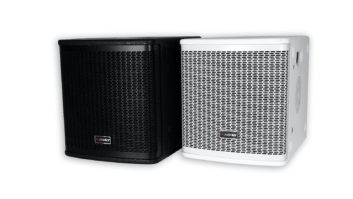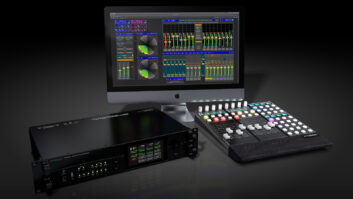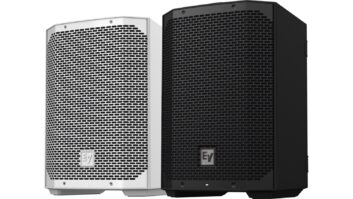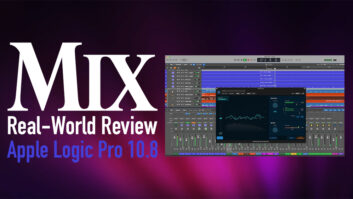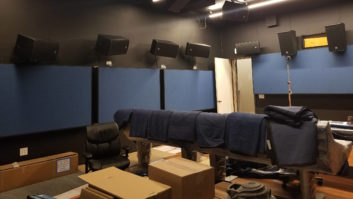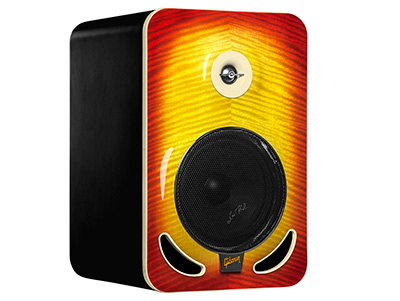
I don’t know what was more shocking about this product when I first saw it: the fact that Gibson was producing a studio monitor, or the fact that it looked like a Les Paul. The idea of Gibson diving into the world of pro speakers was a bit of a surprise, but then the company does own KRK, and has been very active of late.
While the monitors are attractive, looks don’t generally drive a studio monitor purchase; it’s how they actually sound. I was sent a pair of the 8-inch models, the largest in the series.
On Paper
The Les Paul Reference Monitors ($999 each) come in three sizes, each having a 1-inch titanium tweeter covered with a “diamond-like carbon coating.” Hardening an already sturdy titanium tweeter with a smooth, even coating of diamond-like material can improve the ability to maintain shape, while incurring a minimal increase in cost and weight.
Each model is named according to the size of its woofer—4, 6 or 8 inches. The 4-inch is housed in a modest 10.16 x 6.54 x 9.49-inch build, in contrast to the very large 18.58 x 12.05 x 13.78-inch enclosure of the 8-inch model. Each version is front-ported, and while the sides have a flat black finish, the front has an arched veneer with flamed maple finish. All three sizes use a bi-amped design with dual Class-D amplifiers. The 6- and 8-inch models both cross over at 2.7 kHz, and claim identical frequency responses of 37 Hz to 47 kHz. The 4-inch model has a 2.4 kHz crossover point and bottoms out at 55 Hz.
All three models have the same complement of controls and connections on their back panels. There is something for everybody in terms of connectivity, with an unbalanced RCA-type connector being accompanied by an XLR/TRS combo jack for balanced signals. A rocker-type power switch sits next to the standard IEC power connector, while a push-button “standby” control can be found next to the audio input. A “volume” control is provided with unspecified numerical values from 1 to 10 silk-screened around it and no detents. Bass and treble controls are detented at seven positions ranging from flat to +/-1 dB, +/-2 dB to +/- 4dB.
In Use
I received a pair of the large Les Paul 8 monitors for review. I was immediately taken aback by the size. They look bigger in real life than they do in pictures. My mix room is not giant, so it was clear that when these went up, there would not be much room for any other monitors. I finished a mix that I was working on referencing a pair of Focal Twin6 Be before I made the swap, but decided to just switch one at first, to A-B.
I flipped on the Les Paul monitor and turned up the volume control to about halfway. Immediately I heard a good amount of noise from the amplifier. Assuming that, perhaps, there was no need to crank them, I turned the volume control on the amp down until the subtle hiss from both monitors matched in level. Upon playing back, the Focal was dramatically louder than the Gibson monitor. It is worth noting that the Focals are a high-dollar 300W three-way design, while the LP8s are a 247W two-way. That said, in order to get the output levels to match I had to crank the Les Paul volume control to just between “8” and “9” which brought the noise floor to a clearly noticeable level. Granted, I was only a few feet away from the speaker, and perhaps at a greater distance, in a larger room, this would not have been so much of an issue.
My first impression was that the monitor sounded really tight, like it needed to be broken in quite a bit. In general, the top was much more forward than the Focal, and there seemed to be a real lack of any sort of bottom end. This would change with time, and with a little work on the EQ controls. In the first place, cranking the bass control to +4 dB and dialing back the treble to -4 dB seemed to help quite a bit. I thought I should revisit the comparison and just loosen up the Les Paul monitors as a pair, get to know their character. I fed them a lot of music and listened to them change over the next few weeks, finally maturing into something much more impressive.
Eventually, the bottom end dropped and a rich, tight, low-frequency thump emerged. Kick drums and electric bass each had a push that was extremely realistic. Even when pushing quick repetitive transients in EDM or metal mixes, this bottom end stayed very articulate and never muddied up. One thing that helped and hurt the lows was a hole that seemed to be punched out of the lower mids. There seemed to be a bit of an attenuated notch centered around 300 Hz that effectively “cleaned up” the lower midrange. It also robbed vocals of a good amount of their chestiness and thinned out the body of snares. When listening to really crowded rock or electronic music mixes, the overall effect was not as problematic, as the bass stayed tight and there was enough going on in the upper mids that I didn’t really miss anything. When I tried mixing a piece with voiceover and music, however, there were issues with the mix translating. On any other speakers, there was an audible low-mid buildup in the mix that I failed to address given the feedback provided by the monitors.
The tweeter seemed to produce an impressive amount of clarity and detail. Snares and cymbals were extremely crisp and clean. There was great separation between vocals, acoustic guitar strings, pianos, and the buzzy harmonics of a distorted electric bass or synths. Everything was really open with a nice airiness on the top of drums. Even after listening for long periods, the top end didn’t seem overwhelmingly fatiguing.
It felt like the overall image and frequency response improved when I turned the monitors on their sides, rather than having them vertical. They sounded a little thin when upright, and the perceptible midrange seemed to fill in when they were on their sides. Granted, there are a lot of factors like room size, relative distance to walls and acoustic treatment that combine with the speaker orientation to produce an overall sound. That said, I always preferred the sound of these monitors with the highs turned to -4 dB, and the lows boosted to +4 dB, placed horizontally with the tweeters to the inside.
The stereo field was great, and the frequency response seemed quite smooth, aside from the slight dip around 300 Hz and a bit of a push from 2 kHz to 4 kHz. Listening to dense ’70s funk, there were centered vocals, softly panned drums and guitars, but then horns extended out to edges far beyond the width of the speaker boxes. A similar width was very apparent in modern dance-pop, with synths living outside the edges of the speakers, giving nearly 180 degrees of width to the sound field. The more they broke in, the more I started to enjoy listening to music on these monitors.
Going back and finally A-B’ing the broken-in Les Paul monitors against the Focals, the Les Paul’s held up a lot better. There was an extra octave of bottom end coming from the 8-inch woofer that was not being produced by the Focals’ 6-inch driver. The lower-midrange still seemed a little flatter on the Focal side of things, but the upper mids and highs turned into an actual contest. The top end from the Les Paul speakers always sounded more forward than the Focals, but in terms of detail and articulation, it was really close.
The Final Word
It’s reasonable to believe that some people might prefer the slightly accentuated top end of the Les Pauls, and considering that the Focal monitors cost almost twice as much as the Gibsons, it’s not too much of a surprise that they are a bit flatter, in general. If you’re thinking about getting these 8s, be aware that they are big, and if you plan to keep them upright, you will likely need an angled stand or recoil stabilizer to point the tweeters down at your head. If the frequency response is really as close as they say, I’d like check out the 6’s, as their enclosures aren’t as towering. Altogether, I very much enjoyed listening to music on these speakers, and while there were some pros and cons, if you’re looking for a conversation piece in your room, these will certainly get something going.
